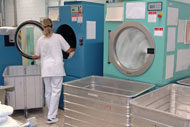About this seriesThis series of tutorial articles is a joint project of the Association for the Healthcare Environment and Health Facilities Management. |
Many factors influence which hospital or provider holds and keeps the status of "provider of choice." Today's economic climate has increased competition across the spectrum of consumer-driven products and services, including available health care choices.
The information age in which we now live has created a customer base with more readily available information, which has led to higher expectations of the consumer health care experience.
What can be done to differentiate one hospital from the competition across the street or down the block? Does the hospital expand the services it offers? Does it renovate its clinics or add square footage? Does it launch a marketing campaign to draw new segments of the local market? Does it redesign its front entrance to make a grand first impression? The choices would be limitless, if hospitals didn't have budget restrictions.
An often-overlooked opportunity to make a good first impression lies in the contributions well-trained environmental services (ES) staff can make. From a well-polished floor to reduced health care-associated infections (HAIs) to customer service with a smile, an ES department literally can be a game changer for a hospital's becoming or continuing to be the provider of choice in its market.
Proactive partnering
Across the country, proactive ES departments are partnering with infection control to reduce the risks of HAIs as well as playing a larger role and having a greater impact on patient satisfaction levels.
The Centers for Medicare & Medicaid Services maintains a "Hospital Compare" Web feature (www.hospitalcompare.hhs.gov) wherein anyone with Internet access can compare participating hospitals in their geographic area.
These survey-based results are gathered by post-admission questionnaires sent to recently discharged patients using the Hospital Consumer Assessment of Healthcare Providers and Systems (HCAHPS) survey. [The Department of Veterans Affairs maintains similar measures of patient satisfaction called the Survey of Healthcare Experiences of Patients scores, which includes a similar question regarding cleanliness of the hospital environment.
One of the 10 measures reported in the standard survey results on the website asks, "During this hospital stay, how often were your room and bathroom kept clean?" Talk about a good chance to make a first and lasting impression!
Thoughts differ greatly as to what "clean" truly means and many of the common answers by traditional methods are subjective. However, there are many objective, measurable ways to quantify levels of cleanliness. A well-structured, quality-assurance monitoring program combines both the subjective and objective measures of what clean means and how it impacts a hospital's bottom line when making a good first impression.
Clean measurements
There are three basic tools or methods for measuring cleanliness that fall into the realm of ES quality-assurance monitoring. They include direct practice observation, adenosine triphosphate (ATP) bioluminescence systems and fluorescent gel monitoring. Each of these methods has merit and each has its place in the hospital setting based on personnel, budgets, availability and other factors.
In direct practice observation, an ES supervisor or other member of hospital management observes ES staff cleaning the patient room or does a visual inspection after the room has been completely cleaned. This can be evaluated statistically by use of a visual checklist to quantify results. The problem with this method is that it is very subjective.
For instance, "ES Supervisor A" and "Infection Control Practitioner B" probably have quite different standards of what they consider to be clean. Additionally, they may have biases such as past experience that skew the results. This also means that direct observation results cannot be reliably reproduced between quality inspectors from day to day or even across work shifts within a 24-hour period. This also is the type of subjective evaluation that HCAHPS scores measure when a patient's opinion is sought on how often they considered their rooms and restrooms to have been kept clean.
ATP systems have been used in the food service industry for about 30 years and measure the amount of surface contamination present on objects. ATP monitors express the amount of bioburden on a surface in a measure called relative light units (RLUs) by taking a swab culture of environmental surfaces.
It is good from a managerial point of view that the level of cleanliness can be measured objectively. It takes the human factor out of the equation and can produce reliable, reproducible results under the right circumstances. An area yet to be regulated adequately with ATP monitoring, and therefore a limitation, is that there are no consistently accepted or published standards about which RLU measurement benchmark equates to a clean surface for health care ES staff purposes.
ATP devices can vary significantly in their readings. Results produced by ATP systems also can vary with the user. In addition, without a structured and audited training and monitoring program to teach quality-assurance staff how large an area to culture swab and how to use the monitoring device properly, results can be skewed. Furthermore, to get a true picture of the level of cleaning, both pre- and post-cleaning readings must be taken. Each reading takes about 30 seconds and involves taking a swab of a surface and then inserting the swab into the monitoring device to be read. This can be labor intensive, especially if monitoring 10 to 20 surfaces in a room both before and after the cleaning process takes place.
Fluorescent gel monitoring involves the application of an invisible fluorescent mark on environmental surfaces prior to room cleaning and then going back after cleaning to see if the mark has been removed through a combination of the mechanical action and the chemical process of cleaning.
This is a very basic way to monitor whether surfaces have been wiped down and is less time- and labor-intensive than ATP monitoring. Each mark takes about 10 seconds to place on a surface and check after cleaning. If the mark has been removed, and the manager has varied the locations on which the marks are placed, the manager can be reasonably assured over time that the surface and the room have been cleaned thoroughly.
There are limitations to this method as well, such as the challenge of clandestinely placing the marks on surfaces without the knowledge of ES staff. If an ES technician sees a quality-assurance specialist or manager enter the room, he or she likely will know the room is being monitored and then may clean that room differently, potentially producing artificially better monitoring results. The biggest advantage of the fluorescent gel system is its simplicity.
A quality-assurance specialist still should use visual observation to determine if the rest of the room has been cleaned thoroughly.
Customer considerations
Quality-assurance monitoring in the health care environment is more than measuring cleanliness. A good quality-assurance program also should have a customer service or public relations aspect. A quality-assurance specialist can, and should, be a customer service trainer and monitor for ES staff. Customer service in this regard is much more than simply being quick and responsive to clean up spills or ensuring that discharge beds are turned over efficiently in preparation for the next hospital admission.
ES customer service and quality assurance should be part public relations, part self-promotion and all about caring for the patient and visitors. In addition to proper hand hygiene, the Centers for Disease Control and Prevention (CDC) in their Guidelines for Environmental Infection Control in Health-Care Facilities (www.cdc.gov/mmwr/preview/mmwrhtml/rr5210a1.htm) recognizes that "cleaning and disinfecting environmental surfaces as appropriate is fundamental in reducing their potential contribution to the incidence of health care-associated infections."
ES staff should be trained to know this information and encouraged to share the facts in suitable ways with patients and other customers who are present when the ES technicians are servicing their rooms. Front-line ES staff and their supervisors should be coached to interact with their patients daily and discuss their role in the hospital as partners in the infection prevention process. They also should share with patients and visitors why they are cleaning in the manner demonstrated [see sidebar, this page].
An ES technician who engages in conversation with patients while cleaning their rooms will create a much more memorable patient experience than a technician who quietly slips into the room to empty the trash without interacting with the patient. That quality interaction just might be the difference that leads the patient to answer the question "How often were your room and bathroom kept clean?" on the HCAHPS survey in a positive way.
ES technicians can spend quality time in a patient's room while they clean by engaging the patient in polite conversation as well as describing who they are, who they work for and why they're doing what they're doing in the patient room. Generally, an ES technician can carry on these conversations with little or no interruption or extra time spent in the rooms.
A good program
A good environmental quality-assurance program starts with education and training and progresses to setting standards, monitoring processes and results, and using results as training opportunities to improve service.
Throughout the process, customer service and patient interaction should be emphasized. Quality-assurance monitoring using these guidelines leads to a good first impression, but also pays dividends after discharge. HFM
Brian Tallmadge, CHESP, is assistant chief of environmental management service at Ralph H. Johnson VA Medical Center, Charleston, S.C. He can be reached at Brian.Tallmadge@va.gov.
| Sidebar - Carolina VA facility makes leap in cleaning satisfaction scores |
| Using the principles described in this article, the Ralph H. Johnson VA Medical Center (RHJVAMC) in Charleston, S.C., over a one-year period improved its patient satisfaction scores related to patient perception of room cleanliness as well as independent objective measures of cleanliness. During this period, the environmental services (ES) team focused on customer service interactions as they went about their daily routines cleaning the hospital. The hospital's Survey of Healthcare Experiences of Patients (SHEP) scores have trended upward every quarter and continue to do so. One year later, the SHEP scores improved more than eight percent and the medical center is now surpassing its performance measure goal of 91 percent patient satisfaction for room cleanliness. ES management also implemented fluorescent gel monitoring in their patient rooms and restrooms during this time to monitor discharge cleaning. The gel monitoring focused on the 17 high-touch areas the Centers for Disease Control and Prevention recommends in their December 2010 toolkit, "Options for Evaluating Environmental Cleaning" (www.cdc.gov/hai/toolkits/evaluating-environmental-cleaning.html). The objects were determined to be those most highly touched in a patient's room and, therefore, most likely to harbor and potentially transmit disease. The 17 high-touch objects have been monitored and measured more than 3,200 times at RHJVAMC throughout the year and improvements of more than 70 percent were made on some objects. At the end of the fiscal year, RHJVAMC averaged 90 percent success in patient restrooms and 91 percent success in patient rooms for a 90.5 percent overall success rate for environmental monitoring. This achievement was accomplished through consistent improvement efforts by front-line ES staff and continuous training and education provided by a joint effort of ES management and the facility's multidrug-resistant organism coordinator. |





